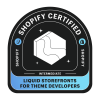Bounce rate is an internet analytics metric that quantifies the number of website visitors who see a single page and, after that, leave without additional interaction with the rest of the site. To calculate the bounce rate divide the total number of visits per page by the total number of entries to the site. This article will explain what bounce rate is, why it happens and how to reduce it.
What is the typical e-commerce bounce rate #
The typical e-commerce bounce rate is between 20% and 45%. In e-commerce, examples of bounce rate include site visitors that:
- Arrived on the store homepage and left without taking more actions
- Arrived at a product page and did not interact with it before leaving the website
- Landed on the contact page, found the information they wanted, and left
Data from CXL says that e-commerce websites have lower average bounce rates than various other sites. This indicates an e-commerce bounce rate listed below 20% is astonishing, between 20% and 45% is ordinary, and above 45% could be troublesome. With all standards, nevertheless, there is always more to the tale. Think about these two circumstances:
- Site visitor A arrives on product pages and exits after a few seconds
- Site visitor B gets on product pages and invests a couple of minutes before leaving
Without extra context, the company could assume that visitor B is more interested in its products because he spent more time on a web page than visitor A. However, site visitor A may have anticipated something particular he couldn’t immediately discover and left in disappointment, while site visitor B could have had zero need to purchase anything and just maintained reading out of interest.
There is no difference between either scenario in Google Analytics’ eyes: they’re both a bounce. But for a website owner, supervisor, or optimizer, recognizing what happened in situation B, where something was either busted or impossible to locate, might be the key to improving the bounce rate and conversions.
Here are the average bounce rates in different industries:
- Informational pages: 40-60%
- Blog posts: 70-98%
- Lead generation websites: 30-50%
- Service websites: 10-30%
- Retail websites: 20-40%
- Landing pages: 70-90%
How to reduce bounce rate #
With all these discussed points, we can confidently say that reducing the bounce rate is a top priority for any e-commerce business. While there are many tactics, strategies, tips, and tricks to reduce the bounce rate, these are the 4 major things online retailers should focus on first.
Target the right keywords/channels #
It’s most likely that a high bounce rate shows traffic that does not fit the target audience. Google Analytics is a great tool to establish which traffic sources drive less desirable visitors. If the website draws in the wrong crowd, site visitors usually bounce. Optimizing search phrases and picking the right channels is crucial.
Improve usability #
Design a website that is simple to navigate and looks good to make sure that new visitors will wish to stay there. The company can enhance the usability of its website by readjusting the size of headings, selecting the ideal typefaces, selecting contrasting colors, utilizing the white space and bulleted listings, and enhancing the info design of your pages.
Optimize for mobile #
This is among the essential regulations that the e-commerce business should not neglect. Users are progressively going shopping on their mobiles. A website that gives a great experience and is responsive will no doubt have a lower bounce rate.
Do A/B testing #
When a company is unsure which decisions will improve UX and reduce bounce rate, it’s always good to do A/B testing. A/B is a test in which two different versions of the same page are created and set to appear to different visitors when they arrive to measure which option performed better in traffic retention. The company can consolidate the winner or switch from it to another A/B test, constantly improving its numbers.
Do you want to learn more about e-commerce? Continue reading about → Customer journey e-commerce.

